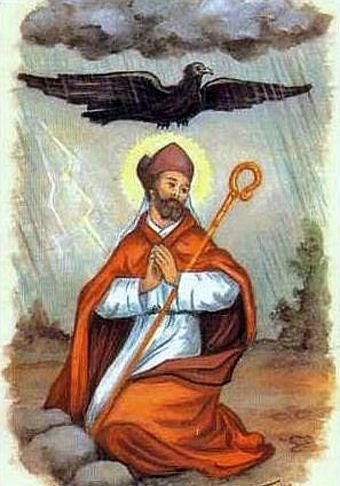
Today is the feast day of St. Medard of Noyon, who was also known as St. Medardus (c. 456–545). “He was the Bishop of Noyon. He moved the seat of the diocese from Vermand to Noviomagus Veromanduorum (modern Noyon) in northern France. Medardus was one of the most honored bishops of his time, often depicted laughing, with his mouth wide open, and therefore he was invoked against toothache.” He is also the patron of brewers, as well as vineyards and good harvests. “He is sometimes depicted with a giant eagle hovering over his head to shelter him from rain, while others around him got wet (reputedly this occurred while he was a child.) This led to his association with control over the weather.”

This account is from CatholicSaints.Info:
Born c.470 in Salency, Picardy, France; died c.558. Born of a Frankish noble father and a Gallo-Roman mother, Saint Medard was educated at Saint-Quentin. He is also the brother of Saint Gildard, archbishop of Rouen. At 33, he was ordained to the priesthood and became so successful as a missioner that he was chosen to succeed Bishop Alomer in 530 in the see of Vermandois. Medard may have been consecrated by Saint Remigius of Rheims.
According to an unreliable tradition, Medard moved his see from Saint-Quentin to Noyon after a raid by the Huns, then united it with the diocese of Tournai. Allegedly Noyon and Tournai remained under one bishop for 500 years.
Medard is known to have given the veil to Queen Saint Radegund. He is credited with the institution of the old local custom of Rosiere. Each year where his feast is celebrated, the young girl who has been judged the most exemplary in the district is escorted by 12 boys and 12 girls to the church, where she is crowned with roses and given a gift of money (Benedictines, White).
In art, an eagle shelters Saint Medard from the rain, a reference to the legend that this happened when he was a child (Roeder). This may explain the origins of the superstition that if it rains on his feast day, the next 40 days will be wet; if the weather is good, the next 40 will be fine as well (White). He might also be portrayed with two horses at his feet, leaving footprints on stone, or holding a citadel (Roeder). In Medieval art, Medard may be laughing with his mouth wide open (le ris de Saint Medard), and for this reason he is invoked against toothache (White).
Saint Medard is the patron of brewers, peasants, prisoners (Roeder), corn harvests, and vintage (White). He is invoked on behalf of idiots and lunatics, as well as for fruitfulness, both in child-bearing and in the fields, for rains and vineyards, and against bad weather and toothache (Roeder).

Why exactly he’s a patron of brewers or vineyards or good harvests is not very clear, and I can find no satisfactory answer. The only logical assumption may have to do with association with rain, but that’s admittedly a bit of a stretch.

There’s also a Brasserie Saint Médard in France that was founded in 2015 that uses the saint in their logo and on their beer bottles.

